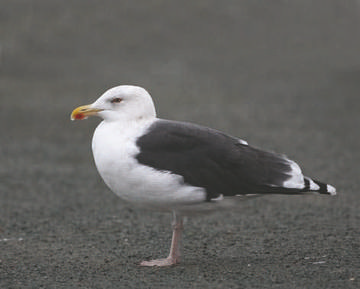Great Black-backed Gull (Larus marinus)

Great Black-backed Gull © Richard Steel
One glance at the winter map for Great Black-backed Gull immediately shows the aptness of its scientific name – the marine gull. A century ago they were virtually unknown inland in Cheshire (Coward 1910): the only instance then on record was that of one shot in Witton Flashes in 1898 and recorded as an albatross! They started to be found inland from the early 1920s, visiting the Flashes and Marbury Mere, mostly from October to February, often only one at a time and very rarely more than three or four together (Boyd 1951). Bell repeated this assessment in his 1962 book, but in his 1967 supplement he wrote that ‘indications are that inland occurrences are becoming more frequent and in larger numbers’. This Atlas map shows them now to be probably more widespread than ever before, but still scarce more than a few kilometres away from the tidal Dee or Mersey.
As expected, the submitted habitat records show that more than half of the tetrads with the species included an ‘H’ (marine) code. There were 23 records on farmland, compared to 85 for Herring Gull and 98 for Lesser Black-backed Gull. Their distribution is noticeably influenced by landfill sites at Maw Green (SJ75E), Dane’s Moss (SJ97A) and Gowy (SJ47K/ L). The effect of these artificial feeding sites should not be exaggerated, however, and they are not numerous compared to other large gulls: cannon-netting by Merseyside Ringing Group at waste disposal sites in the Warrington area during the 1990s caught just nine Great Black-backed Gulls compared to 1344 Herring Gulls and 1166 Lesser Black-backed Gulls. The largest flocks during this Atlas period were 250 on Hoylake shore and the same number adjacent to the Gowy landfill site in SJ47G, with about 200 on the Mersey at Richmond Bank, near to the Arpley landfill site (SJ58T). The median count was of only five birds. Great Black-backed Gulls forage mainly on natural marine foods although these gulls can be fearsome predators and scavengers: the highest-altitude bird, in (SJ96P), was feeding on a sheep carcase.
The birds wintering in the county are thought to be predominantly breeding birds from the Irish Sea coasts, the nearest colonies being on Puffin Island, Gwynedd and the Calf of Man, and from the west of Scotland, which undertake a general southward movement in winter. Females are twice as likely as males to move inland. Norwegian Great Black-backed Gulls – indistinguishable in colour or size – are common along the east coast but rarely penetrate to the west coast of Britain (BTO Winter Atlas).
Great Black-backed Gulls were reported during this Atlas period from three tetrads in the breeding season meriting possible breeding status, with adult birds of breeding age present at Frodsham Marsh (SJ47Y/ Z) and Fiddler’s Ferry (SJ58M). Until a few years ago these would not have been thought to be suitable breeding habitat but one pair at Frodsham changed that, breeding there for five years from 1998 to 2002. This event was not welcomed with the usual fanfare and descriptive article in the Cheshire and Wirral Bird Report but was nevertheless notable as the first ever breeding in the county and in an unusual site, on the ground on a tiny heap of mud surrounded by water, rather than the species’ normal offshore rocky islets.
Sponsored by The Rostherne Observatory Wardens

